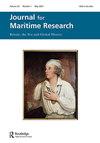Characterising the nation: how T.P. Cooke embodied the naval hero in nineteenth-century nautical melodrama
Q3 Arts and Humanities
引用次数: 0
Abstract
ABSTRACT In the first half of the nineteenth century, nautical melodramas were a popular genre of performance in London’s theatres. During his lifetime, Thomas Potter Cooke (1786–1864) was known as the last and best of stage sailors, and his portrayals of the British sailor became archetypal for many theatregoers. Cooke’s contemporary critics speculated about how his experience at sea informed his performances, which his audiences took great pleasure in. Cooke performed his most popular roles hundreds of times, and portraits of him in character were produced by and sold in London’s stationers. Examples of these ephemeral prints survive in museum collections, and are a useful source of information about the visual significance of performance. This article examines Cooke’s theatrical career and its critical reception. By using contemporary printed ephemera, this article explores how the developing theatrical culture in London both drew on and established ideas about British sailors and the navy. It reflects on how Cooke’s time at sea was used both by critics and the man himself in constructing a narrative beyond the stage. This article examines the pleasure that audiences and critics took in engaging with his Cooke’s embodiment of the British sailor, both on stage and off.刻画国家:T.P.库克如何在19世纪的航海情节剧中塑造海军英雄
在19世纪上半叶,航海情节剧是伦敦剧院流行的一种表演形式。在他的一生中,托马斯·波特·库克(1786-1864)被认为是最后也是最好的舞台水手,他对英国水手的描绘成为许多戏剧爱好者的原型。库克同时代的评论家猜测他在海上的经历如何影响了他的表演,他的观众非常喜欢。库克出演了他最受欢迎的角色数百次,他的人物肖像由伦敦的文具商制作并出售。这些短暂的版画的例子保存在博物馆的收藏中,是关于表演视觉意义的有用信息来源。本文考察了库克的戏剧生涯及其评论界的接受。本文通过使用当代印刷的蜉蝣,探讨了伦敦发展中的戏剧文化是如何吸收和建立起关于英国水手和海军的观念的。它反映了库克在海上的那段时间是如何被评论家和他自己用来构建舞台之外的叙事的。这篇文章探讨了观众和评论家在与库克在舞台上和舞台下的英国水手的化身互动时所获得的乐趣。
本文章由计算机程序翻译,如有差异,请以英文原文为准。
求助全文
约1分钟内获得全文
求助全文
来源期刊

Journal for Maritime Research
Arts and Humanities-History
自引率
0.00%
发文量
0
期刊介绍:
The Journal for Maritime Research ( JMR ), established by the National Maritime Museum in 1999, focuses on historical enquiry at the intersections of maritime, British and global history. It champions a wide spectrum of innovative research on the maritime past. While the Journal has a particular focus on the British experience, it positions this within broad oceanic and international contexts, encouraging comparative perspectives and interdisciplinary approaches. The journal publishes research essays and reviews around 15-20 new books each year across a broad spectrum of maritime history. All research articles published in this journal undergo rigorous peer review, involving initial editor screening and independent assessment, normally by two anonymous referees.
 求助内容:
求助内容: 应助结果提醒方式:
应助结果提醒方式:


